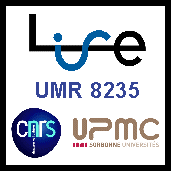Elementally resolved dissolution kinetic via AESEC-EIS methodology for a NiCrFeMn(Mo)Co highentropy alloy system
Résumé
The high-entropy alloys (HEAs) have been introduced as next-generation materials that can be used in highly corrosive environments due to their superior corrosion resistance compared to conventional steels in aqueous and non-aqueous media. The alloy design using thermodynamic approach, and enhanced mechanical/corrosion properties of the HEAs have been relatively well reported, however, identifying the contribution of each alloying elements to the passivation and dissolution mechanisms are less well explored to date. The overall corrosion mechanism of the HEAs is likely dependent on the specific chemical and electrochemical properties of each alloying elements and their interactions with each other. To this end, we have recently developed a methodology to monitor the elementally resolved passivation/dissolution kinetics of the HEAs using atomic emission spectroelectrochemistry (AESEC) coupled with electrochemical impedance spectroscopy (EIS). This methodology can provide complementary information to the conventional EIS as we could decompose the elemental specific faradaic reactions contributing to the EIS response. The AESEC-linear sweep voltammetry (AESEC-LSV) and AESEC-EIS have been carried out for the nominally pure metals, components of Ni-based alloys and HEAs to monitor the element specific electrochemical response during potentiodynamic polarization and EIS experiments. Elementally resolved electrochemical parameters, e.g., elemental Tafel slopes, were determined both by AESEC-LSV and AESEC-EIS at open circuit potential (Eoc). The elementally resolved Nyquist and Bode plots were obtained in a relatively low frequency domain (f < 10 Hz). The results of the pure metals will be used as input parameters to understand the elemental passivation/dissolution kinetics, elemental contribution to the impedance, and interfacial properties of the NiCr, Ni-Cr-Mo alloys, and Ni-Fe-Cr-(Mn)-Co HEAs.
Fig. 1(a) shows AESEC-LSV of pure Ni, Cr, Fe and Co measured in a deaerated 2 M H2SO4 solution with 0.5 mV s-1 scan rate. A near congruent Ni dissolution was observed in the active potential domain. Less soluble Cr-based species formation is indicated in a relatively large potential domain (0.0 V < E < 1.0 V vs. SCE) in that the total current density (je) was higher than the equivalent Cr dissolution current density (jCr). Fe showed an onset dissolution potential (-0.68 V vs. SCE) more negative than the potential at j = 0 (Ej=0), and je > jFe for E > Ej=0 indicating a Fe-based less soluble species formation in this potential domain. Co showed a complex dissolution mechanism as a function of potential with 4 to 6 orders of magnitude jCo and je difference. An example of AESEC-EIS is given in Fig. 1(b) in the case of pure Ni showing an in-phase Ni dissolution rate with the applied sinusoidal potential, and resulting je. The Bode plots for pure Ni, Cr, Fe, Mo, and Co are compared with a Ni-Fe-Cr-Mn-Co HEA

